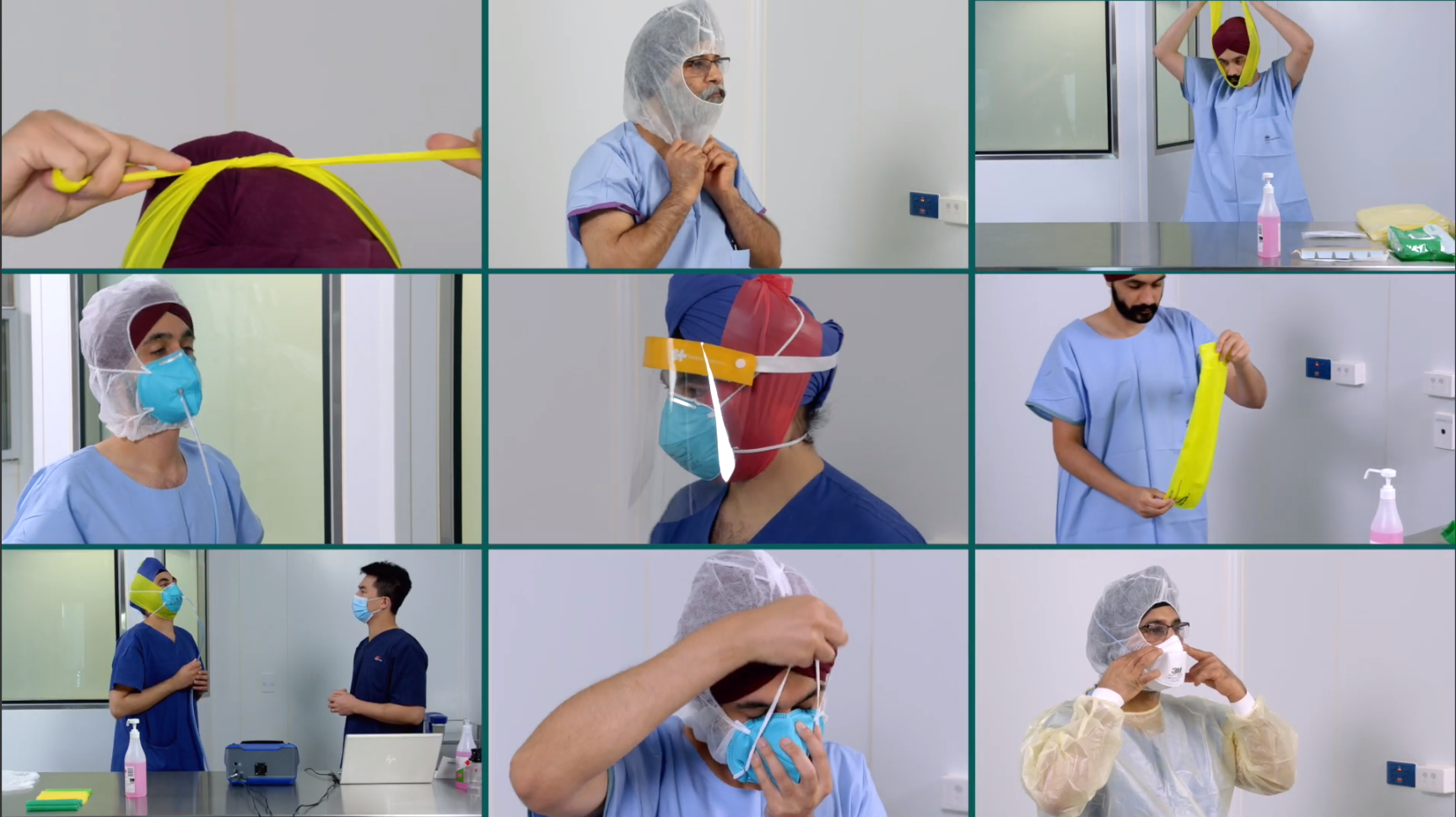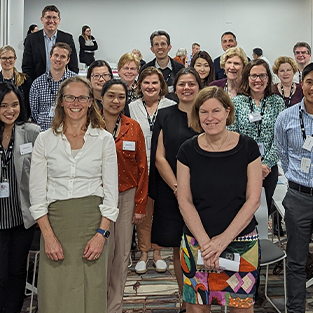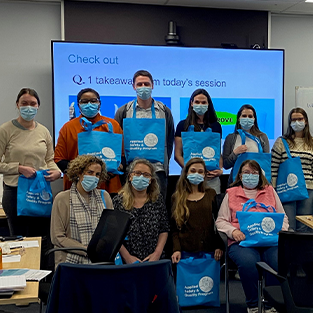Key Achievements
In 2021-22:
- The CEC's input to the COVID-19 pandemic response continued across 24 quarantine hotels, airport and patient transport services. The CEC expert infection prevention and control professionals (ICPs) and specialist "IPAC Connect" staff provided electronic auditing, expert guidance, and program development. The CEC conducted 925 audits, made 543 recommendations (all actioned) and held 144 education sessions.
- The CEC risk-assessed 928 notifications for issues with medical devices, medicines and biological agents. Of these, 53 required system-wide critical responses and 32 required Urgent Safety Alert Broadcasts. Three critical device issues and four urgent medication issues required rapid activations of an Inter-agency Management team, with weekly management meetings.
- The CEC continued to lead and enhance the state-wide Respiratory Protection Program with participation from more than 100,000 health workers.
- The CEC launched a podcast series with senior clinicians sharing their leadership journey in safety and quality. Each conversation is an engaging narrative on the significance of psychological safety to facilitate open discussions that enable the diversity of perspectives within a team.
- The CEC developed comprehensive training and eLearning modules for staff involved in Serious Adverse Event Reviews (SAERs) to support new NSW Health investigating and reporting requirements. The CEC delivered 31 fundamentals, methodologies, and team leader workshops to local health districts and specialty health networks to June 2022, with over 550 participants.
- The CEC developed a collaborative access model to ensure medicines for reducing hospitalisations and death among at-risk COVID-19 patients were widely accessible. The model allowed community clinicians to prescribe for dispensation at NSW Health pharmacies, in departure from standard practice. Over 5,000 patients accessed treatment.
- The CEC supported the governance framework and initial list of approved medicines for the NSW Medicines Formulary. The Formulary is part of a NSW Health initiative for governing the procurement and usage of pharmaceuticals to support optimum clinical governance and better value health care, leading to improved patient outcomes.
- The CEC collaborated with the Incident Management System (ims+) team and vendor on an automated process for receiving data daily, sorting it and presenting it to users in meaningful ways. The data is triangulated with patient administrative data and integrated into QIDS, a platform which can integrate user data for further insights.
- The CEC implemented the Safety & Quality Essentials Pathway across all NSW Health entities to help reduce harm through tailored workforce capability development. The CEC Academy partnered with 19 NSW Health entities for sustainable local implementation of the pathway.
- The CEC established the data extract for QIDS MatIQ. It already contains data on 140,000 births, is refreshed weekly and currently reflects 75% of NSW's public births using local health district eMaternity data. Over 5,000 trend and multilocation reports are generated each month, supporting NSW's clinicians and maternity services and improving patient safety.
- The health system lead for Infection Prevention and Control (IPC), the CEC provided critical pandemic guidance, resources and education. The CEC supported IPC practitioners with a new NSW Health CEC Infection Prevention and Control Leadership program and a comprehensive infection prevention and control (IPAC) manual. The CEC also supported the system and community with IPC advice for the emerging Monkeypox virus.
COVID-19 response

With the COVID-19 pandemic continuing in its second year, the CEC's Healthcare Associated Infections (HAI), Infection Prevention and Control (IPAC) and Medication Safety teams continued to play a critical role as the lead agency for infection prevention and control and medication safety in NSW.
As COVID-19 case numbers increased, waves fluctuated, variants of concern and even variants of interest evolved with the emergence of sub lineages, the priority remained keeping all health workers, patients and visitors safe. Supporting the system with strategic guidance, advice, resources and education formed the core of the CEC response.
The HAI/IPAC team continued supporting the COVID-19 response with IPAC expertise, consultation and expanding their comprehensive range of resources that provide clear clinical guidelines for the NSW Health community and beyond.
Keeping our health workers safe was a priority, with 16 'staying safe' resources developed for staff. The CEC IPAC team continued leading the NSW Respiratory Protection Program (RPP) with over 150,000 fit tests completed across NSW Health, almost 500 staff trained to fit test in NSW and close to 80 fit test assessors becoming trainers. Information on a "Beard Wrapping" fit technique was published in collaboration with the Australian Sikh Doctors, as was a paper outlining lessons learned on the implementation of the RPP within healthcare facilities during the COVID-19 pandemic.
The CEC reviewed visitation guidelines to ensure staff, patients and community safety while providing kind and compassionate care. The Hotel Quarantine program was scaled down to completion in 2022, with the CEC closing out the IPAC quality auditing framework which supported the quarantine and airport programs. This involved developing an IPAC auditing framework for 24 quarantine hotels, introducing electronic auditing, conducting 890 onsite audits, 939 reports, 540 recommendations and 134 formal education sessions until its cessation on 30 April 2022. The CEC provided informal education sessions and developed an innovative IPAC Risk and Incident Management Classification framework. The IPAC Connect program led to the establishment of the IPAC leadership program with 26 candidates.
The Medication Safety team similarly provided expert medication advice to NSW Health clinicians and patients, producing nine drug guidelines with supporting materials for patients in multiple languages.
"Thank you! The CEC team have been incredible role models to all of us – you leave so many new IPAC proteges in your wake."
Hotels and Accommodation Lead, NSW State Health Emergency Operations Centre (SHEOC) COVID-19, 2022
"Thanks for your expertise, accessibility, flexibility, support, partnership and advice on many strange requests! Hugely appreciated by SHEOC and the NSW community."
State Health Emergency Operations Centre (SHEOC) COVID-19 staff member, 2022
The CEC successfully supported Infection Prevention and Control practitioners who continued to be impacted by the pandemic by implementing a first of its kind leadership and mentoring framework in partnership with University of Technology Sydney.
"I want to express my heartiest thanks to each and every one of you for the kindness, support and guidance throughout my time with CEC. Being under the supervision of a highly experienced team is a fantastic experience. Each one of you inspires me to work hard and dream big. I feel lucky to work with such an excellent and valuable team in CEC. It was a fruitful journey in my career. Always grateful for the mentorship and leadership throughout my work. I wish you all the very best."
IPAC Connect and Leadership Registered Nurse, Cohort 1
The IPAC leadership program incorporates reflective practice, action learning sets, open discussions, insights from key leaders within the health system and an enhanced mentoring component.
"Accept my heartfelt gratitude for taking time from your busy schedule yesterday to mentor me. I'm honoured to have had this opportunity and for the valuable lessons that you shared with me. I will take on board the lessons and encouragement you shared with me, and I look forward to sharing my achievements with you along the way."
IPAC Leadership member, Cohort 2
One of the CEC's key achievements was the COVID-19 IPAC Manual, a consolidated and consistently reviewed guide for IPAC for acute and non-acute healthcare settings, including patient and health worker risk matrix guides.
There were 1.5 million webpage views and over 316,000 downloads of CEC resources during 2021-22. Over 15,000 NSW Health staff completed the My Health Learning Personal Protective Equipment (PPE) training modules.
The CEC IPAC team formed a partnership with HealthShare to provide direct and ongoing IPAC expertise and tailored resources in response to COVID. We provided education and training aimed at keeping staff safe. For medications, HealthShare NSW and eHealth NSW were strategic partners in enabling timely access to medications and producing electronic prescribing declarations in the eMR for all sites to use.
Another first for Australia and NSW was the emergence of Monkeypox cases. The CEC provided expert IPAC advice and resources to manage Monkeypox in health and general community care settings.
Staff wellbeing initiative
In 2020 the workplace changed forever with the sudden emergence of the COVID-19 pandemic. Regardless of organisational policy, employers were forced into flexible working arrangements under the weight of public health orders to reduce or prevent infection with COVID-19.
The CEC swiftly shifted to predominantly remote working. At the time, there was not yet a vaccine or end in sight for the pandemic response, placing the health system, the CEC and its workforce under enormous pressures in the context of government regulation, infection prevention and control, and intense media coverage.
At the end of FY2020-2021, 40% of staff were working outside of the CEC due to COVID-19 redeployments. Re-deployments included returning to frontline clinical roles, joining different and new teams within the CEC, and supporting contact tracing efforts. For many staff, their redeployment roles were very different to their CEC roles and often involved potential exposure to the COVID-19 virus. Such circumstances could have led to feelings of uncertainty, increasing staff fatigue, anxiety, burnout and depression.
The CEC 2021-2024 Strategic Plan recognises our people as one of our four key organisational enablers making it possible to deliver our strategic vision. The Plan identifies that CEC staff are supported and have the skills to provide expert safety advice to support the system.
To mitigate potential negative impacts on well-being and performance into FY2021-2022, the CEC launched a Staff Wellbeing Plan, a program of interventions aimed at supporting CEC staff and leaders to lead and work during a significant time of uncertainty. The interventions were designed to target skill development and coping strategies to manage through this period, reduce uncertainty and increase one's capacity to work with uncertainty. This created a shared understanding of such experiences and an open dialogue to recognise, speak up and support our own and each other's wellbeing.
To start, the CEC conducted a baseline measurement of staff wellbeing using the Team Psychological Safety Scale and Short Warwick-Edinburgh Mental Wellbeing Scale.
The Plan's interventions included:
- Weekly organisational updates at the Huddle led by Chief Executive
- Capability development for leading and working in uncertainty
- 1:1s for people manager leadership development on how to lead high-performing teams and self through uncertainty
- Facilitated team sessions to improve task cohesion – replaced by individualised support to directorates and teams
- Organisational Schwartz Rounds
- Process for handing over when mental or physical care is needed
- Mindfulness sessions and mindfulness integration into the workday
- Safety Fundamentals and how to use them at the CEC in a virtual workplace
- Newsletter updates on staff wellbeing and linking to HealthShare and Employee Assistance Program resources and information
- Process for collecting information about staff wellbeing to inform future interventions.
As the Plan's implementation progressed, the CEC used qualitative and quantitative measures in a QARS survey to assess staff satisfaction with the interventions. This "pulse" survey was repeated six times throughout the Plan's delivery to track progress. The CEC also reviewed workforce data such as annual leave, sick leave and turnover as additional information points.
The CEC focused on ensuring staff took regular breaks and time off to maintain wellbeing, with an improvement in excessive leave and additional day off (ADO) balances throughout this period. Throughout the Plan's implementation from July 2021 through to June 2022, CEC staff reported small but steady improvements in wellbeing (from 3.57 to 3.69 on the Short Warwick-Edinburgh Mental Wellbeing Scale). The CEC's 2021 People Matter Employee Survey also showed a strong wellbeing result at 82% favourable.
While the focus of the CEC was on supporting the system with resources, tools and information, we also deliberately focused conversation and activity on supporting staff wellbeing. We found that it matters to staff and that the CEC looks forward to continuing and sustaining its future focus on staff health and wellbeing initiatives.
Our thanks
For the preparation of this document, we thank the management, clinical staff and Communications teams at Western NSW Local Health District and Southern NSW Local Health District.



